mobile View, to the German Version tap the flag


- State of Qatar
- absolute monarchy
- own name: Dawlat al Qatar
• Flag
• Historical Flags
• Meaning/Origin of the Flag
• Coat of Arms
• Meaning/Origin of the Coat of Arms
• Aircraft Roundel
• Map
• Numbers and Facts
• History
• Origin of the Country's Name
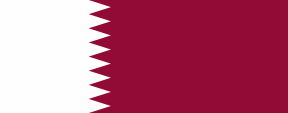
National flag,
ratio = 11:28,
Source, by: Wikipedia (DE)






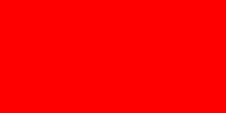
1822–ca. 1868,
National flag,
Source, by: Flags of the World



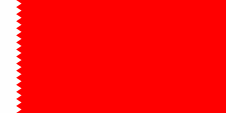
ca. 1868–1916,
National flag,
Source, by:
Flags of the World




1932-1936,
National flag,
Source, by:
Flags of the World



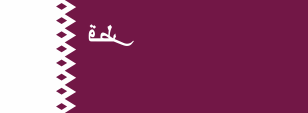
1936-1949,
National flag,
ratio = 11:30,
Source, by: Flags of the World



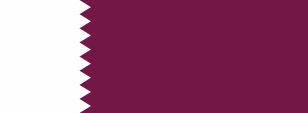
1949–1971,
National flag,
ratio = 11:30,
Source, by: Flags of the World




The flag of Qatar is auburn-coloured with an on the staff side situated vertical a nine-pointed white stripe, its width is approximatly 2/3 of the height of the flag. The flag is similar to the flag of Bahrain (colour-combination red-white). The Color is officially set as Pantone 1955 C since 2015. Previously, Pantone 222 C was in use. Initially Qatar used also red and white, the colours of nearly all Gulf States, and has its roots possibly in the flag of Bahrain, but was however changed in the years. The Fact is that at the beginning a narrow white vertical stripe at the Mast was separated from a large red field by a zigzag cut. That zigzag cut has been subject to some changes over the years. For the 30's of the 20th century, even a waveline has been handed down, but this may also have been emerged by incorrect observation or even inaccurate production. Transitional there were small lozenges in the white part near the tops of the zigzag line, and even the name of the land appeared in the red part. The typical tone, the "Qatar Maroon" came ostensibly into being by influence of the sunshine on the natural dyes and is in use perhaps since 1932. Oher sources mention the year 1949. One source (Wikipedia) explains it this way: The region around Al-Chaur was known for centuries for the production of purple color from purple snails, which found good living conditions here in the waters of the Persian Gulf. Sheikh Mohammed bin Thani (1847-1876) wanted to use the color purple on the new flag, when the long-disputed country, which had found its approval as a state as British Protectorate of Qatar. However, United Kingdom wanted a colour-combination of white and red, just as they were used from those Gulf Sheikdoms that had joined the Anti-Piracy-Treaty of 1820. In 1932 Britain and Qatar once again had discussions about the flag, Qatar prevailed this time, in using on its own a mixed colour of red and purple. These, at that point in time still natural colors, had not been durable and could have changed quickly, by sunlight, heat, wind or water. As a result, the original color was lost and the flags appeared to the viewer as brown, which spread as a brown flag in the whole world and could not be corrected. With the introduction of the Pantone color system, the color was fixed on Pantone 222 C by Qatar, which perhaps came closest to the original purple-red color. This shade is modeled in the historical flag illustrations on this page. However, the brown flag was too well known in the world and the unusual color simply could not prevail and the country lacked the ability to control and to stop it. In 2015 they decided in Qatar to come a little bit closer to the world-famous brown and redefined the color new as Pantone 1355 C. In 1949 the format of the flag (ratio of the sides) was also set for the first time, at 11:30, since 1971 it has to be 11:28. Red is in the area of the Indian Ocean and the Persian Gulf a traditional flag's colour with close connections to the Islam, because it is the colour of the Sherifs of Mekka, and it is a symbol of the in the eastern Arabia living islamic Chahridshites. Red flags have and had the Arabian Emirates, Oman or also Zanzibar, just as all islamic dynasties, which descent from the Alawites (as well Alides, descentants of Ali → e.g. today's Morokko, former North Yemen). The most emirates and sheikdoms in and near the Persian Gulf signed in 1820 a first general sea-treaty with United Kingdom, which should stop the piracy in the region of the Persian Gulf. As a sign of acceptance, the undersigned emirates and sheikhdoms surrounded their traditional red flags with a white border. In the 20th century, was often used only a white stripe on the mast, or the flags were individually modified.
Source: Wikipedia (EN), Die Welt der Flaggen


since 2022,
Coat of arms of Qatar,
Source, by:
Cesar David MP, CC0, via Wikimedia Commons
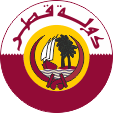
1976–2022,
Coat of arms of Qatar,
Source, by:
Corel Draw 4,
Flaggen Wappen Hymnen

The coat of arms of the state shows above of two each other turned twisted swords a Dhau, a traditional arabian ship, and two palm trees. Above that the name of the land in arabian typeface. The coat of arms is surrounded in the colours of the flag. It was officially introduced about 1976.
Source:
Flaggen Wappen Hymnen,
Flaggen und Coat of arms of the Welt


Aircraft Roundel,
Source, by: Wikipedia (EN)

Location:
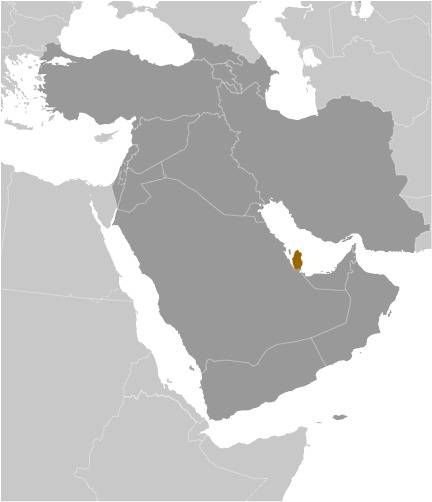
Source: CIA World Factbook
Map of the country:
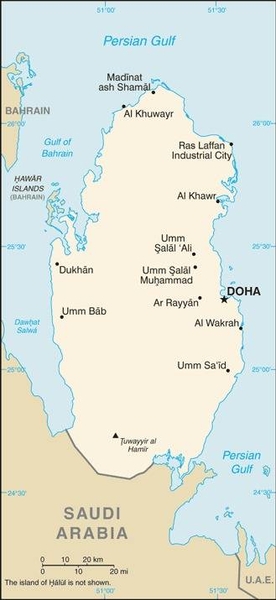
Source: CIA World Factbook

Area: 4.489 square miles
Inhabitants: 2.677.000 (2021), thereof 11% Qatari, 29% other Arabs, 36% Pakistani and Indians, 10% Persian
Religions: 65% Muslim, 15% Hindu, 14% Christian, 3% Buddhist
Density of Population: 596 inh./sq.mi.
Capital: Doha (Ad Dauhah), 587.055 inh. (2015)
official Language: Arabic
other Languages: Persian, English
Currency: 1 Qatar Riyal (QAR, QR) = 100 Dirham
Time Zone: GMT + 3 h
Source:
Wikipedia (DE),
Wikipedia (EN)

634 · conquest by the Arabic Califate, Islamization
ca. 1560 · conquest by the Ottoman Empire
1602 · temporary affiliation with the Sultanate of Masquat/Oman
ca. 1760 · the only sporadically by Bedouins visited waterless peninsula becomes the target of Bedouin tribes, which settle here, among them the Al-Thani Clan from Arabia and the Al-Chalifa Clan from Kuwait, which fight each other bitterly until the Al-Chalifa conquer Bahrain in 1783 to later establish their sheikhdom there
1822 · the al-Thani family founds the Sheikhdom of Qatar
1867 · war between Qatar and Bahrain, Britain intervenes in favor of Qatar and enforces the peace
1868 · Qatar becomes a British Protectorate and is thus recognized as a state
1872 · Qatar comes under the influence of the Ottoman Empire, Turkish troops are stationed
1913 · United Kingdom ends the influence of the Ottoman Empire and neighbouring Arabs
1916 · withdrawal of the last Turkish troops
1956 · the USA lease for 99 years the place Al-Sabane as fleet base, meanwhile changed in a support pact
1968 · withdrawal of the British troops
1st of September 1971 · Qatar becomes independent from United Kingdom as an emirate
1972 · coup d'état within the ruling dynasty Al Thani
1994 · once more border-quarrels with Bahrain because of the Jazirat-Hawar Archipelago
1995 · coup d'état within the ruling dynasty Al Thani
1996 · coup d'état tryed by members of the dynasty Al Thani
1999 · first free and democratic elections, Qatar and Saudi-Arabia enclose their border-quarrels
2017 · Qatar Crisis, states of the Region cut their diplomatic ties with Qatar because of allegations of supporting terrorism
Source:
Wikipedia (DE),
Discovery '97,
Weltgeschichte

The name of the country can be proven until the first Century A.D., when Pliny the Elder called the inhabitants of the peninsula as "Catharrei". About one hundred years later, a map of Ptolemy shows the peninsula as "Catara". One can only guess that the name goes back to an ancient, then well-known settlement. The ancestors of the Arabs who live here today did not arrive here until the end of the 18th century. They adopt the old name for their Sheikhdom.
Source:
Wikipedia (EN)


![]()


















